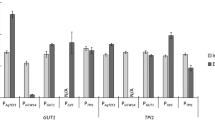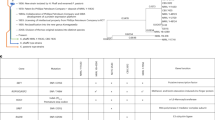Abstract
Combining ease of genetic manipulation and fermentation with the ability to secrete and to glycosylate proteins in the basic eukaryotic manner, Arxula adeninivorans provides an attractive expression platform. Based on a redesign of the basic vector, a new Arxula vector system, Xplor® 2, for heterologous gene expression was established, which allows (1) the construction of expression plasmids for supertransformation of A. adeninivorans strains secreting target proteins of biotechnological interest and (2) the integration of small vector cassettes consisting of yeast DNA sequences only. For this purpose, a set of modules including the ATRP1m selection-marker module, expression modules for constitutive expression of the genes phyK (Klebsiella-derived phytase) and IFNα2a (human interferon α), the HARS (Hansenula polymorpha autonomous replication sequence) for autonomous replication and the chaperone module AHSB4 promoter –HpCNE1 gene (calnexin) –PHO5 terminator to improve secretion efficiency were constructed and integrated in various combinations in the basic vector Xplor® 2. After removal of the complete Escherichia coli-based plasmid parts (resistance marker, ColE1 ori and f1(−) origin), the remaining yeast-based linear vector fragment with or without rDNA targeting sequences were transformed as yeast rDNA integrative expression cassettes and yeast integrative expression cassettes (YICs), respectively, and the resulting strains were tested for their capacity to secrete PhyK or IFNα2a. Maximal expression levels were consistently obtained using YICs for transformation irrespective of whether or not they carry HARS and/or calnexin modules. It is recommended that at least 50 such transformants be analyzed to ensure selection of the best transformants.






Similar content being viewed by others
References
Böer E, Mock HP, Bode R, Gellissen G, Kunze G (2005) An extracellular lipase from the dimorphic yeast Arxula adeninivorans: molecular cloning of the ALIP1 gene and characterization of the purified recombinant enzyme. Yeast 22:523–535
Böer E, Steinborn G, Kunze G, Gellissen G (2007a) Yeast expression platforms. Appl Microbiol Biotechnol 77:513–523
Böer E, Steinborn G, Matros A, Mock HP, Gellissen G, Kunze G (2007b) Production of interleukin-6 in Arxula adeninivorans, Hansenula polymorpha, and Saccharomyces cerevisiae applying the wide range vector (CoMed™) system to simultaneous comparative assessment. FEMS Yeast Res 7:1181–1187
Böer E, Steinborn G, Florschütz K, Körner M, Gellissen G, Kunze G (2009a) Arxula adeninivorans (Blastobotrys adeninivorans)—a dimorphic yeast of great biotechnological potential. In: Satyanarayana T, Kunze G (eds) Yeast biotechnology—diversity and application. Springer, The Netherlands, pp 453–468
Böer E, Bode R, Mock HP, Piontek M, Kunze G (2009b) Atan1p—an extracellular tannase from the dimorphic yeast Arxula adeninivorans: molecular cloning of the ATAN1 gene and characterization of the recombinant enzyme. Yeast 26:323–337
Bradford MM (1976) A rapid and sensitive method for the quantification of microgram quantities of protein utilizing the principle of protein-dye binding. Anal Biochem 72:248–254
Degelmann A, Müller F, Sieber H, Jenzelewski V, Suckow M, Strasser AW, Gellissen G (2002) Strain and process development for the production of human cytokines in Hansenula polymorpha. FEMS Yeast Res 2:349–361
Gienow U, Kunze G, Schauer F, Bode R, Hofemeister J (1990) The yeast genus Trichosporon spec. LS3; molecular characterization of genomic complexity. Zbl Mikrobiol 145:3–12
Hahn T, Tag K, Riedel K, Uhlig S, Baronian K, Gellissen G, Kunze G (2006) A novel estrogen sensor based on recombinant Arxula adeninivorans cells. Biosens Bioelectron 21:2078–2085
Kang HA, Gellissen G (2005) Hansenula polymorpha. In: Gellissen G (ed) Production of recombinant proteins—novel microbial and eukaryotic expression systems. Wiley-VCH, Weinheim, pp 111–142
Kaur P, Lingner A, Singh B, Böer E, Polajeva J, Steinborn G, Bode R, Gellissen G, Kunze G (2007) APHO1 from the yeast Arxula adeninivorans encodes an acid phosphatase of broad substrate specificity. Antonie Van Leuuwenhoek 91:45–55
Klabunde J, Kunze G, Gellissen G, Hollenberg CP (2003) Integration of heterologous genes in several yeast species using vectors containing a Hansenula polymorpha-derived rDNA-targeting element. FEMS Yeast Res 4:185–193
Klabunde J, Kleebank S, Piontek M, Hollenberg CP, Hellwig S, Degelmann A (2007) Increase of calnexin gene dosage boosts the secretion of heterologous proteins by Hansenula polymorpha. FEMS Yeast Res 7:1168–1180
Knoll A, Bartsch S, Husemann B, Engel P, Schroer K, Ribeiro B, Stöckmann C, Seletzky J, Büchs J (2007) High cell density cultivation of recombinant yeasts and bacteria under non-pressurized and pressurized conditions in stirred tank bioreactors. J Biotechnol 132:167–179
Kunze I, Hensel G, Adler K, Bernard J, Neubohn B, Nilssen C, Stoltenburg R, Kohlwein SD, Kunze G (1999) The green flourescent protein targets secretory proteins to the yeast vacuole. Biochim Biophys Acta 1410:287–298
Kurtzmann CP, Robnett JC (2007) Multigene phylogenetic analysis of the Trichomonascus, Wickerhammiella and Zygoascus yeast clades, and the proposal of Sugiyamaella gen. nov. and 14 new species combinations. FEMS Yeast Res 7:141–151
Middelhoven JW, Hoogkamer-Te Niet MC, Kreger van Rij NJW (1984) Trichosporon adeninovorans sp. nov., a yeast species utilizing adenine, xanthine, uric acid, putrescine and primary n-alkylamines as the sole source of carbon, nitrogen and energy. Antonie Van Leeuwenhoek 50:369–387
Middelhoven WJ, de Jonge IM, Winter M (1991) Arxula adeninivorans, a yeast assimilating many nitrogenous and aromatic compounds. Antonie Van Leeuwenhoek 60:129–137
Middelhoven WJ, Coenen A, Kraakman B, Gelpke MDS (1992) Degradation of some phenols and hydroxybenzoates by the imperfect ascomycetous yeasts Candida parapsilosis and Arxula adeninivorans: evidence for an operative gentisate pathway. Antonie Van Leeuwenhoek 62:181–187
Rose MD, Winston F, Hieter P (1990) Methods in yeast genetics. A laboratory manual. Cold Spring Harbor Laboratory, Cold Spring Harbor
Rösel H, Kunze G (1998) Integrative transformation of the dimorphic yeast Arxula adeninivorans LS3 based on hygromycin B resistance. Curr Genet 33:157–163
Sajidan A, Farouk A, Greiner R, Jungblut P, Müller EC, Borriss R (2004) Molecular and physiological characterization of a 3-phytase from soil bacterium Klebsiella sp. ASR1. Appl Microbiol Biotechnol 65:110–118
Sohn JH, Choi ES, Kim CH, Agaphonov MO, Ter-Avanesyan MD, Rhee JS, Rhee SK (1996) A novel autonomously replication sequence (ARS) for multiple integration in the yeast Hansenula polymorpha DL-1. J Bacteriol 178:4420–4428
Steinborn G, Gellissen G, Kunze G (2005) Assessment of Hansenula polymorpha and Arxula adeninivorans-derived rDNA-targeting elements for the design of Arxula adeninivorans expression vectors. FEMS Yeast Res 5:1047–1054
Steinborn G, Böer E, Scholz A, Tag K, Kunze G, Gellissen G (2006) Application of a wide-range yeast vector (CoMed™) system to recombinant protein production in dimorphic Arxula adeninivorans, methylotrophic Hansenula polymorpha and other yeasts. Microb Cell Factories 5:33
Steinborn G, Gellissen G, Kunze G (2007a) A novel vector element providing multicopy vector integration in Arxula adeninivorans. FEMS Yeast Res 7:1197–1205
Steinborn G, Wartmann T, Gellissen G, Kunze G (2007b) Construction of an Arxula adeninivorans host–vector system based on trp1 complementation. J Biotechnol 127:392–401
Tanaka A, Ohnishi N, Fukui S (1967) Studies on the formation of vitamins and their function in hydrocarbon fermentation. Production of vitamin B6 by Candida albicans in hydrocarbon medium. J Ferment Technol 45:617–623
Terentiev Y, Pico AH, Böer E, Wartmann T, Klabunde J, Breuer U, Babel W, Suckow M, Gellissen G, Kunze G (2004a) A wide-range integrative yeast expression vector system based on Arxula adeninivorans-derived elements. J Ind Microbiol Biotechnol 31:223–228
Terentiev Y, Breuer U, Babel W, Kunze G (2004b) Non-conventional yeasts as producers of polyhydroxyalkanoates—genetic engineering of Arxula adeninivorans. Appl Microbiol Biotechnol 64:376–381
Van der Walt JP, Smith MT, Yamada Y (1990) Arxula gen. nov. (Candidaceae), a new anamorphic, arthroconidial yeast genus. Antonie Van Leeuwenhoek 57:59–61
Wartmann T, Krüger A, Adler K, Bui MD, Kunze I, Kunze G (1995) Temperature dependent dimorphism of the yeast Arxula adeninivorans LS3. Antonie Van Leeuwenhoek 68:215–223
Wartmann T, Böer E, Huarto-Pico A, Sieber H, Bartelsen O, Gellissen G, Kunze G (2002) High-level production and secretion of recombinant proteins by the dimorphic yeast Arxula adeninivorans. FEMS Yeast Res 2:363–369
Wartmann T, Stoltenburg R, Böer E, Sieber H, Bartelsen O, Gellissen G, Kunze G (2003a) The ALEU2 gene—a new component for an Arxula adeninivorans-based expression platform. FEMS Yeast Res 3:223–232
Wartmann T, Bellebna C, Böer E, Gellissen G, Kunze G (2003b) The constitutive AHSB4 promoter—a novel component of the Arxula adeninivorans-based expression platform. Appl Microbiol Biotechnol 62:528–535
Acknowledgements
The authors are grateful to Dr. P. Hardy for helpful discussions and critical reading of the manuscript and R. Franz and H. Bohlmann for excellent technical assistance. The research work was supported by grants from the German national Ministry of Education and Research (BMBF) within the CLIB2021 cluster (Wettbewerb Industrielle Biotechnologie 2021) and the Fonds der chemischen Industrie (GK).
Author information
Authors and Affiliations
Corresponding author
Rights and permissions
About this article
Cite this article
Böer, E., Piontek, M. & Kunze, G. Xplor® 2—an optimized transformation/expression system for recombinant protein production in the yeast Arxula adeninivorans . Appl Microbiol Biotechnol 84, 583–594 (2009). https://doi.org/10.1007/s00253-009-2167-5
Received:
Revised:
Accepted:
Published:
Issue Date:
DOI: https://doi.org/10.1007/s00253-009-2167-5




